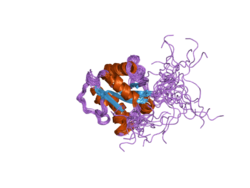Biology:Toll-interleukin receptor
| TIR domain | |||||||||
|---|---|---|---|---|---|---|---|---|---|
 Structure of the MyD88 TIR domain | |||||||||
| Identifiers | |||||||||
| Symbol | TIR | ||||||||
| Pfam | PF01582 | ||||||||
| InterPro | IPR000157 | ||||||||
| SCOP2 | 1fyv / SCOPe / SUPFAM | ||||||||
| OPM superfamily | 289 | ||||||||
| OPM protein | 2mk9 | ||||||||
| Membranome | 7 | ||||||||
| |||||||||
The toll-interleukin-1 receptor (TIR) homology domain is an intracellular signaling domain found in MyD88, SARM1, interleukin-1 receptors, toll receptors and many plant R proteins. It contains three highly conserved regions, and mediates protein-protein interactions between the toll-like receptors (TLRs) and signal-transduction components. TIR-like motifs are also found in plant proteins where they are involved in resistance to disease and in bacteria where they are associated with virulence.[1][2] When activated, TIR domains recruit cytoplasmic adaptor proteins MyD88 (UniProt Q99836) and TOLLIP (toll-interacting protein, UniProt Q9H0E2). In turn, these associate with various kinases to set off signaling cascades. Some TIR domains have also been found to have intrinsic NAD+ cleavage activity, such as in SARM1.[3][2][4] In the case of SARM1, the TIR NADase activity leads to the production of Nam, ADPR and cADPR and the activation of downstream pathways involved in Wallerian degeneration and neuron death.[3]
In Drosophila melanogaster the toll protein is involved in establishment of dorso-ventral polarity in the embryo. In addition, members of the toll family play a key role in innate antibacterial and antifungal immunity in insects as well as in mammals. These proteins are type-I transmembrane receptors that share an intracellular 200 residue domain with the interleukin-1 receptor (IL-1R), the toll/IL-1R homologous region (TIR). The similarity between toll-like receptors (TLRs) and IL-1R is not restricted to sequence homology since these proteins also share a similar signaling pathway. They both induce the activation of a Rel type transcription factor via an adaptor protein and a protein kinase.[5] MyD88, a cytoplasmic adaptor protein found in mammals, contains a TIR domain associated to a DEATH domain (see InterPro: IPR000488).[5][6][7] Besides the mammalian and Drosophila melanogaster proteins, a TIR domain is also found in a number of plant proteins implicated in host defense.[8] As MyD88, these proteins are cytoplasmic.
Site directed mutagenesis and deletion analysis have shown that the TIR domain is essential for toll and IL-1R activities. Sequence analysis have revealed the presence of three highly conserved regions among the different members of the family: box 1 (FDAFISY), box 2 (GYKLC-RD-PG), and box 3 (a conserved W surrounded by basic residues). It has been proposed that boxes 1 and 2 are involved in the binding of proteins involved in signaling, whereas box 3 is primarily involved in directing localization of receptor, perhaps through interactions with cytoskeletal elements.[9]
Subfamilies
Human proteins containing this domain
IL18R1; IL18RAP; IL1R1; IL1RAP; IL1RAPL1; IL1RAPL2; IL1RL1; IL1RL2; MYD88; SIGIRR; TLR1; TLR10; TLR2; TLR3; TLR4; TLR5; TLR6; TLR7; TLR8; TLR9; SARM1;
References
- ↑ "NAD+ cleavage activity by animal and plant TIR domains in cell death pathways". Science 365 (6455): 793–799. August 2019. doi:10.1126/science.aax1911. PMID 31439792. Bibcode: 2019Sci...365..793H.
- ↑ 2.0 2.1 "TIR Domain Proteins Are an Ancient Family of NAD+-Consuming Enzymes". Current Biology 28 (3): 421–430.e4. February 2018. doi:10.1016/j.cub.2017.12.024. PMID 29395922.
- ↑ 3.0 3.1 "The SARM1 Toll/Interleukin-1 Receptor Domain Possesses Intrinsic NAD+ Cleavage Activity that Promotes Pathological Axonal Degeneration". Neuron 93 (6): 1334–1343.e5. March 2017. doi:10.1016/j.neuron.2017.02.022. PMID 28334607.
- ↑ "The SARM1 TIR NADase: Mechanistic Similarities to Bacterial Phage Defense and Toxin-Antitoxin Systems". Frontiers in Immunology 12: 752898. 2021. doi:10.3389/fimmu.2021.752898. PMID 34630431.
- ↑ 5.0 5.1 "T1/ST2 signaling establishes it as a member of an expanding interleukin-1 receptor family". The Journal of Biological Chemistry 271 (10): 5777–5783. March 1996. doi:10.1074/jbc.271.10.5777. PMID 8621445.
- ↑ "IRAK (Pelle) family member IRAK-2 and MyD88 as proximal mediators of IL-1 signaling". Science 278 (5343): 1612–1615. November 1997. doi:10.1126/science.278.5343.1612. PMID 9374458. Bibcode: 1997Sci...278.1612M.
- ↑ "Toll signaling pathways in the innate immune response". Current Opinion in Immunology 12 (1): 13–19. February 2000. doi:10.1016/s0952-7915(99)00045-x. PMID 10679407.
- ↑ "Plant disease-resistance proteins and the gene-for-gene concept". Trends in Biochemical Sciences 23 (12): 454–456. December 1998. doi:10.1016/s0968-0004(98)01311-5. PMID 9868361.
- ↑ "Identification of two major sites in the type I interleukin-1 receptor cytoplasmic region responsible for coupling to pro-inflammatory signaling pathways". The Journal of Biological Chemistry 275 (7): 4670–4678. February 2000. doi:10.1074/jbc.275.7.4670. PMID 10671496.
 |

